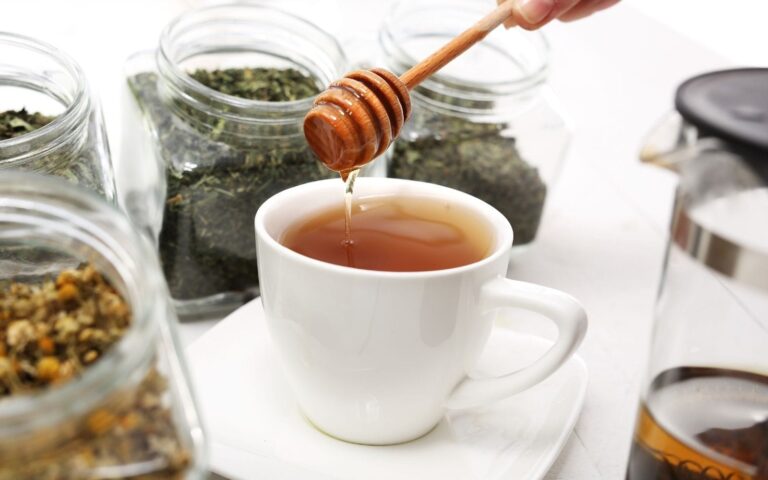What Does Matcha Taste Like And How To Enjoy It?

Disclosure: This post may contain affiliate links. If you click on a link we may make a small commission at no extra cost to you. You can read the full disclosure here
What Does Matcha Taste Like?
Matcha is a popular form of traditional Japanese tea that has a deep, aromatic flavor. Just like any other type of tea, it may be brewed to make a hot or cold drink; however, there are many ways people choose to enjoy matcha. It can be consumed as a meal replacement powder, added to smoothies or juices, used in baking, mixed with oatmeal, combined with ice cream or yogurt, and even sprinkled over ice cream.
Does matcha tea actually taste good?
Not all Matcha is the same and flavors can vary widely from bitter to savory to grassy yet sweet. Therefore, describing the Matcha experience can fail to do it justice. This exquisite green tea is complex, aromatic, rich, and alluring at its best. So in order to optimize the taste, be selective when you buy and careful when you brew. You can enjoy your Matcha tea hot or cold and even customize it to suit your own taste.
It is made by grinding and drying shade-grown leaves that have been fortified with nutrients and then stone-milled into a fine powder. The color of matcha varies from deep green to light green, it has become popular in recent years as a health drink because of its high antioxidant content. But just what does matcha taste like? It is said to have a strong flavor that many people say is hard to describe. That being said, it does have some similarities to other green teas. For example, it has grassy notes that are similar to green teas like sencha or bancha.
Your taste experience can vary widely depending on the quality of Matcha you use and how it’s prepared. The most prominent tasting notes are often described as vegetal and earthy with characteristics somewhere between smooth and rich to bitter and astringent. So in order to get the most out of this powdered tea and enjoy all it has to offer, it’s necessary to explore its complexities. The key is to create a taste sensation that is just right for you so you will keep coming back for more in order to enjoy its benefits to the full.
Not All Matcha Is The Same

This amazing health drink is in a separate class from regular green tea but there are many factors to consider when it comes to choosing a good Matcha, including type, quality, and grade. So what sets a good Matcha tea apart taste-wise?
Matcha Grades
There are two general types of Matcha grades and these distinctions are used to provide an easy means of categorizing Matcha. However, these terms can often be unreliable as they are unregulated so the quality they suggest isn’t always assured.
In Japan, people look at individual blends of Matcha and their characteristics to evaluate its quality rather than dividing it into two categories. Notably, Japan is known for producing the best Matcha powders.
There are further sub-grades of quality within the overall culinary grade and many of the higher quality sub-grades make an excellent brew on their own. However, some of the lower quality Matcha may require the addition of either artificial or natural sweetness.
☝️This Pure Chimp Tumeric Matcha Green Tea offers a hint of ginger and cinnamon. It’s a powerhouse of anti-oxidants; and tastes devine☝️
Matcha can be delightful but there is a wide range of quality. Look for super-vibrant bright green Matcha blends, that are well balanced so that no one taste is dominant and overpowering everything else. Any initial bitterness should transition gradually into a pleasant aftertaste. It should feel smooth on the tongue and blend gently with your taste receptors.
It’s important to note that a lower grade Matcha doesn’t necessarily mean lower quality. It is usually cheaper in price but as long as it is still green in color and not yellowing, fine in texture, and not gritty or coarse it can still be equally flavorful and bursting with antioxidants. The different grades just tend to be an indication of the alternative flavor profiles.
How To Prepare Matcha To Maximise The Taste

As we have established it is important to first choose your Matcha source wisely, select a grade of Matcha to suit your requirements, and be sure to select a vibrant green powder to ensure quality.
Many people who enjoy Matcha advise the purchase of a Matcha whisk – made from bamboo, it is designed to help whisk Matcha into a lovely creamy foam. Also advised by the experts to enhance your taste experience, is to try sipping your Matcha from a bowl. It is believed you get the optimum flavor this way.
How To Make Matcha Tea More Palatable
High-quality Matcha has a light natural sweetness and is suitable for most people to drink on its own. However, Matcha can be an acquired taste, and if you want to enjoy your tea with milk or sweetener go ahead. Just try not to overwhelm the delicate Matcha flavors by adding too much.
Matcha is so versatile, it mixes well with a wide range of ingredients. It’s worth experimenting with virtually any sweet or savory combination to create a unique flavor profile that might enhance the tea drinking experience for you.
Find out how to sweeten tea without sugar could be a good place to start looking if you’re after a healthier option. Sweetening Matcha may spoil some of the health benefits, but by adding something like honey instead of actual sugar, you are improving nutritional value in other ways.
Why Is Drinking Matcha Green Tea A Good Idea
Matcha green tea has been a staple in Eastern cultures for hundreds of years. In recent times, it has been gaining popularity in the West as people are discovering its immense health benefits. Like green tea, Matcha comes from the Camellia Sinensis plant.
However, it is made from whole leaves ground finely into powder form. Since the entire leaf is consumed you get the full power of key vitamins, minerals, antioxidants, and amino acids, which help to protect the body against disease.
Studies have revealed a variety of health benefits associated with Matcha including:
- Improved cognitive function
- Increased metabolism helping to support weight loss
- Healthier cholesterol levels
- Increased bone mineral density
- Protection against heart disease
- Promotes healthy skin, teeth, and gums
- Reduction in stress
- Enhanced focus and mental clarity
- Energy booster
- Improved digestion
- Protection against certain cancers
- Provides relaxation without drowsiness
- Potential to lower high blood glucose levels.
Matcha is a source of caffeine. It contains more than regular green tea but generally less than coffee. However, unlike coffee, it doesn’t give you that jittery feeling you experience with a caffeine spike. This is because Matcha has a specific amino acid that slows the release of caffeine. This way the body stays energized for a longer period and you tend to enjoy a sense of relaxation without drowsiness.
Matcha is known for being a healthy alternative to coffee for good reason. However, a word of caution, as with most things in life moderation is advised. Especially for individuals who are pregnant or have a caffeine sensitivity. If you have any concerns always check with your health care provider before introducing anything new to your everyday routine.
Conclusion
Matcha can be a rewarding experience in so many ways. However, this flavorful green tea can be a little challenging to get right at first. From its grassy undertones to its lingering exotic sweetness, its taste and scent can be influenced by so many different factors.
As not all Matcha is created equal, choose wisely aiming for the best quality at an affordable price to help you produce a taste sensation to suit your palate that’s packed with flavor and health-promoting properties.
Matcha tea in the morning can be a pleasant way to start your day, as it induces wonderful feelings of calm alertness, leaving you feeling positive and ready for the day ahead. When we choose to adopt a healthier lifestyle, Matcha is a must because the benefits it has to offer are profound.
How is Matcha different from green tea?
Matcha is not just any green tea. It is a finely processed powdered green tea, which gives it an extra rich flavor and aroma that cannot be found in regular brewed or steeped green tea. Matcha is made by grinding the entire leaf down to release the goodness inside. The process of making matcha also decreases the amount of caffeine, so if you are looking for an alternative to your cup of coffee, matcha might be perfect for you.
Does Matcha taste like grass?
Matcha tea is a type of tea that has been consumed for centuries in China and Japan. For some, matcha can be an acquired taste and often tastes like grass when drinking this tea for the first time. However, many people grow to prefer the flavor of Matcha after time because it is much sweeter than other types of green tea and contains health-promoting compounds such as catechins and epigallocatechin gallate (EGCG).
What does Matcha latte taste like?
The taste of a Matcha latte is unique and complex. It can be described as an earthy, grassy flavor with notes of sweetness. It has a smooth and creamy texture and is known for its intense green color and health-giving properties.







